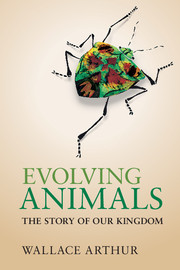Book contents
- Frontmatter
- Dedication
- Contents
- Preface
- Acknowledgements
- 1 What is an animal?
- 2 Before there were animals
- 3 How to make a fossil
- 4 The Cambrian explosion
- 5 How to make a species
- 6 Jellyfish and their kin
- 7 How to make a tree
- 8 The enigmatic urbilaterian
- 9 Animal symmetry and heads
- 10 A plethora of worms
- 11 Trends in animal complexity
- 12 Where the octopus is king
- 13 How to make an animal
- 14 Exoskeletons galore
- 15 Extinction
- 16 Mouth first, mouth second
- 17 Comparing embryos
- 18 Larvae, mouthparts and moulting
- 19 The animal toolkit
- 20 Vertebrate origins and evolution
- 21 From water to land to water
- 22 Variation and inheritance
- 23 Evolutionary novelties
- 24 Human origins and evolution
- 25 Animal plasticity
- 26 The nature of adaptation
- 27 The direction of evolution
- 28 Animal extremophiles
- 29 Extraterrestrial animals?
- 30 The ghost in the machine
- Appendix
- References
- Index
24 - Human origins and evolution
Published online by Cambridge University Press: 05 August 2014
- Frontmatter
- Dedication
- Contents
- Preface
- Acknowledgements
- 1 What is an animal?
- 2 Before there were animals
- 3 How to make a fossil
- 4 The Cambrian explosion
- 5 How to make a species
- 6 Jellyfish and their kin
- 7 How to make a tree
- 8 The enigmatic urbilaterian
- 9 Animal symmetry and heads
- 10 A plethora of worms
- 11 Trends in animal complexity
- 12 Where the octopus is king
- 13 How to make an animal
- 14 Exoskeletons galore
- 15 Extinction
- 16 Mouth first, mouth second
- 17 Comparing embryos
- 18 Larvae, mouthparts and moulting
- 19 The animal toolkit
- 20 Vertebrate origins and evolution
- 21 From water to land to water
- 22 Variation and inheritance
- 23 Evolutionary novelties
- 24 Human origins and evolution
- 25 Animal plasticity
- 26 The nature of adaptation
- 27 The direction of evolution
- 28 Animal extremophiles
- 29 Extraterrestrial animals?
- 30 The ghost in the machine
- Appendix
- References
- Index
Summary
Earlier in the book (Chapter 7), we noted that the evolutionary relationships among the great apes are now well established. The closest living relatives to humans are the chimps. The human and chimp lineages split from each other a little over 6 million years ago (MYA). Although both chimps and humans have changed from our last common ancestor (LCA), we have changed more than they have. The most striking changes in humans are the adoption of an upright, bipedal posture, the marked reduction in body hair, and our increased brain size, with its corollaries of enhanced intelligence and behavioural repertoire.
Here, I’m going to focus on evolution of the brain and intelligence. It’s clear that in this area humans have made something of a quantum leap from the human/chimp LCA, while chimps have not. Let’s adopt an unusual approach to this topic. The object shown in Figure 24.1 is the Huygens lander – a small spacecraft that was launched from a larger one (the Cassini satellite in orbit around the planet Saturn). The Huygens craft has the distinction of having landed further away from Earth than any other object designed and made by humans – to be specific, it landed on the surface of Saturn’s largest moon, Titan.
- Type
- Chapter
- Information
- Evolving AnimalsThe Story of our Kingdom, pp. 241 - 250Publisher: Cambridge University PressPrint publication year: 2014



